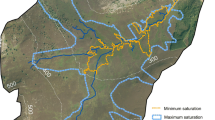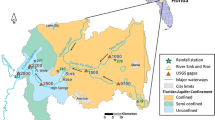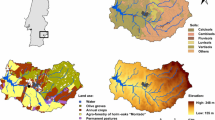Abstract
Preindustrial (1850s) and future (2060) streamwater chemistry of an anthropogenically acidified small catchment was estimated using the MAGIC model for three different scenarios for dissolved organic carbon (DOC) concentrations and sources. The highest modeled pH = 5.7 for 1850s as well as for 2060 (pH = 4.4) was simulated given the assumption that streamwater DOC concentration was constant at the 1993 level. A scenario accounting for an increase of DOC as an inverse function of ionic strength (IS) of soilwater and streamwater resulted in much lower preindustrial (pH = 4.9) and future recovery to (pH = 4.1) if the stream riparian zone was assumed to be the only DOC source. If upland soilwater (where significant DOC increase was observed at −5 and −15 cm) was also included, DOC was partly neutralized within the soil and higher preindustrial pH = 5.3 and future pH = 4.2 were estimated. The observed DOC stream flux was 2–4 times higher than the potential carbon production of the riparian zone, implying that this is unlikely to be the sole DOC source. Modeling based on the assumption that stream DOC changes are solely attributable to changes in the riparian zone appears likely to underestimate preindustrial pH.






Similar content being viewed by others
References
Banwart, S., Menon, M., Bernasconi, S. M., Bloem, J., Blum, W. E. H., de Souza, D. M., et al. (2012). Soil processes and functions across an international network of critical zone observatories: introduction to experimental methods and initial results. Comptes Rendus Geoscience, 344, 758–772.
Battarbee, R. W., Monteith, D. T., Juggins, S., Evans, C. D., Jenkins, A., & Simpson, G. L. (2005). Reconstructing pre-acidification pH for an acidified Scottish loch: a comparison of paleolimnological and modelling approaches. Environmental Pollution, 137(1), 135–149.
Borken, W., Ahrens, B., Schulz, C., & Zimmermann, L. (2011). Site-to-site variability and temporal trends of DOC concentrations and fluxes in temperate forest soils. Global Change Biology, 17(7), 2428–2443.
Bragazza, L., Freeman, C., Jones, T., Rydin, H., Limpens, J., Fenner, N., et al. (2006). Atmospheric nitrogen deposition promotes carbon loss from peat bogs. Proceedings of the National Academy of Sciences of the United States of America, 103(51), 19386–19389.
Buzek, F., Hruška, J., & Krám, P. (1995). Three component model of runoff generation, Lysina catchment, Czech Republic. Water, Air, and Soil Pollution, 79, 391–408.
Clark, J. M., van der Heijden, G. M. F., Palmer, S. M., Chapman, P. J., & Bottrell, S. H. (2011). Variation in the sensitivity of DOC release between different organic soils following H2SO4 and sea-salt additions. European Journal of Soil Science, 62(2), 267–284.
Cosby, B. J., Hornberger, G. M., Galloway, J. N., & Wright, R. F. (1985). Modeling the effects of acid deposition: assessment of a lumped parameter model of soilwater and streamwater chemistry. Water Resources Research, 21, 51–63.
Cosby, B. J., Ferrier, R. C., Jenkins, A., & Wright, R. F. (2001). Modelling the effects of acid deposition: refinements, adjustments and inclusion of nitrogen dynamics in the MAGIC model. Hydrology and Earth System Sciences, 5, 499–518.
Cunningham, L., Bishop, K., Mettavainio, E., & Rosen, P. (2011). Paleoecological evidence of major declines in total organic carbon concentrations since the nineteenth century in four nemoboreal lakes. Journal of Paleolimnology, 45(4), 507–518.
Driscoll, C. T. (1984). A procedure for the fractionation of aqueous aluminum in dilute acidic waters. International Journal of Analytical Chemistry, 16, 267–283.
Driscoll, C. T., Lehtinen, M. D., & Sullivan, T. J. (1994). Modeling the acid–base chemistry of organic solutes in Adirondack, New York, lakes. Water Resources Research, 30(2), 297–306.
Eimers, C. M., Watmough, S. A., Buttle, J. M., & Dillon, P. J. (2008). Examination of the potential relationship between droughts, sulphate and dissolved organic carbon at a wetland-draining stream. Global Change Biology, 14, 938–948.
Ekström, S. M., Kritzberg, E. S., Kleja, D. B., Larsson, N., Nilsson, P. A., Graneli, W., et al. (2011). Effect of acid deposition on quantity and quality of dissolved organic matter in soil-water. Environmental Science & Technology, 45(11), 4733–4739.
Erlandsson, M., Buffam, I., Fölster, J., Laudon, H., Temnerud, J., Weyhenmeyer, G. A., et al. (2008). Thirty-five years of synchrony in the organic matter concentrations of Swedish rivers explained by variation in flow and sulphate. Global Change Biology, 14, 1191–1198.
Erlandsson, M., Cory, N., Fölster, J., Köhler, S., Laudon, H., Weyhenmeyer, G. A., et al. (2011). Increasing dissolved organic carbon redefines the extent of surface water acidification and helps resolve a classic controversy. Bioscience, 61, 614–618.
Evans, C. D., Monteith, D. T., & Cooper, D. M. (2005). Long-term increases in surface water dissolved organic carbon: observations, possible causes and environmental impacts. Environmental Pollution, 137(1), 55–71.
Evans, C. D., Goodale, C., Caporn, S., Dise, N., Emmett, B., Fernandez, I., et al. (2008). Does elevated nitrogen deposition or ecosystem recovery from acidification drive increased dissolved organic carbon loss from upland soil? A review of evidence from field nitrogen addition experiments. Biogeochemistry, 91(1), 13–35.
Evans, C. D., Jones, T. G., Burden, A., Ostle, N., Zielinski, P., Cooper, M. D. A., et al. (2012). Acidity controls on dissolved organic carbon mobility in organic soils. Global Change Biology, 18(11), 3317–3331.
Fölster, J., Andrén, C., Bishop, K., Buffam, I., Cory, N., Goedkoop, W., et al. (2007). A novel environmental quality criterion for acidification in Swedish lakes—an application of studies on the relationship between biota and water chemistry. Water, Air, and Soil Pollution: Focus, 7, 331–338.
Gunnarsson, U. (2005). Global patterns of Sphagnum productivity. Journal of Bryology, 27, 269–279.
Holmberg, M., Vuorenmaa, J., Posch, M., Forsius, M., Lundin, L., Kleemola, S., et al. (2013). Relationship between critical load exceedances and empirical impact indicators at Integrated Monitoring sites across Europe. Ecological Indicators, 24, 256–265.
Hruška, J., & Krám, P. (1994). Aluminium chemistry of the root zone of forest soil affected by acid deposition at the Lysina catchment, Czech Republic. Ecological Engineering, 3, 5–16.
Hruška, J., & Krám, P. (2003). Modelling long-term changes in stream water and soil chemistry in catchments with contrasting vulnerability to acidification (Lysina and Pluhuv Bor, Czech Republic). Hydrology and Earth System Sciences, 7(4), 525–539.
Hruška, J., Köhler, S., Laudon, H., & Bishop, K. (2003). Is a universal model of organic acidity possible: comparison of the acid/base properties of dissolved organic carbon in the boreal and temperate zones. Environmental Science and Technology, 37, 1726–1730.
Hruška, J., Krám, P., McDowell, W. H., & Oulehle, F. (2009). Increased dissolved organic carbon (DOC) in central European streams is driven by reductions in ionic strength rather than climate change or decreasing acidity. Environmental Science & Technology, 43(12), 4320–4326.
Kopáček, J., & Veselý, J. (2005). Sulfur and nitrogen emissions in the Czech Republic and Slovakia from 1850 till 2000. Atmospheric Environment, 39, 2179–2188.
Kopáček, J., Hejzlar, J., Káňa, J., Norton, S. A., Porcal, P., & Turek, J. (2009). Trends in aluminium export from a mountainous area to surface waters, from deglaciation to the recent: effects of vegetation and soil development, atmospheric acidification, and nitrogen-saturation. Journal of Inorganic Biochemistry, 103(11), 1439–1448.
Krám, P., Hruška, J., Driscoll, C. T., & Johnson, C. E. (1995). Biogeochemistry of aluminum in a forest catchment in the Czech Republic impacted by atmospheric inputs of strong acids. Water, Air, and Soil Pollution, 85, 1831–1836.
Krám, P., Hruška, J., & Shanley, J. B. (2012). Streamwater chemistry in three contrasting monolithologic catchments. Applied Geochemistry, 27, 1854–1863.
Löfgren, S., & Zetterberg, T. (2011). Decreased DOC concentrations in soil water in forested areas in southern Sweden during 1987–2008. Science of the Total Environment, 409(10), 1916–1926.
Löfgren, S., Gustafsson, J. P., & Bringmark, L. (2010). Decreasing DOC trends in soil solution along the hillslopes at two IM sites in southern Sweden—geochemical modeling of organic matter solubility during acidification recovery. Science of the Total Environment, 409(1), 201–210.
Moldan, F., Hruška, J., Evans, C. D., & Hauhs, M. (2012). Experimental simulation of the effects of extreme climatic events on major ions, acidity and dissolved organic carbon leaching from a forested catchment, Gårdsjön, Sweden. Biogeochemistry, 107(1–3), 455–469.
Moldan, F., Cosby, B. J., & Wright, R. F. (2013). Modeling past and future acidification of Swedish lakes. Ambio, 42, 577–586.
Monteith, D. T., Stoddard, J. L., Evans, C. D., de Wit, H. A., Forsius, M., Høgåsen, T., et al. (2007). Dissolved organic carbon trends resulting from changes in atmospheric deposition chemistry. Nature, 450, 537–540.
Oulehle, F., McDowell, W. H., Aitkenhead-Peterson, J. A., Krám, P., Hruška, J., Navrátil, T., et al. (2008). Long-term trends in stream nitrate concentrations and losses across watersheds undergoing recovery from acidification in the Czech Republic. Ecosystems, 11(3), 410–425.
Oulehle, F., Cosby, B. J., Wright, R. F., Hruška, J., Kopácek, J., Krám, P., et al. (2012). Modelling soil nitrogen: the MAGIC model with nitrogen retention linked to carbon turnover using decomposer dynamics. Environmental Pollution, 165, 158–166.
Pärn, J., & Mander, U. (2012). Increased organic carbon concentrations in Estonian rivers in the period 1992–2007 as affected by deepening droughts. Biogeochemistry, 108, 351–358.
SanClements, S. D., Oelsner, G. P., McKnight, D. M., Stoddard, J. L., & Nelson, S. J. (2012). New insights into source of decadal increases of dissolved organic matter in acid-sensitive lakes of the Northern United States. Environmental Science & Technology, 46, 3212–3219.
Sarkkola, S., Koivusalo, H., Laurén, A., Kortelainen, P., Mattsson, T., Palvaiainen, M., et al. (2009). Trends in hydrometeorological conditions and streamwater organic carbon in boreal forested catchments. Science of the Total Environment, 408, 92–101.
Schecher, W. D., & Driscoll, C. T. (1987). An evaluation of uncertainty associated with aluminum equilibrium calculations. Water Resources Research, 23, 525–534.
Schöpp, W., Posch, M., Mylona, S., & Johansson, M. (2003). Long-term development of acid deposition (1880–2030) in sensitive freshwater regions in Europe. Hydrology and Earth System Sciences, 7, 436–446.
SEPA. (2010). Status, potential and quality requirements for lakes, watercourses, coastal and transitional waters. In: Handbook 2007:4. 107 p, Stockholm, Swedish Environmental Protection Agency.
Stutter, M. I., Lumsdon, D. G., & Rowland, A. P. (2011). Three representative UK moorland soils show differences in decadal release of dissolved organic carbon in response to environmental change. Biogeosciences, 8(12), 3661–3675.
Tipping, E., Rowe, E. C., Evans, C. D., Mills, R. T. E., Emmett, B. A., Chaplow, J. S., et al. (2012). N14C: A plant-soil nitrogen and carbon cycling model to simulate terrestrial ecosystem responses to atmospheric nitrogen deposition. Ecological Modelling, 247, 11–26.
Wright, R. F., & Cosby, B. J. (2003). Future recovery of acidified lakes in southern Norway predicted by the MAGIC model. Hydrology and Earth System Sciences, 7, 467–485.
Zhang, J., Hudson, J., Neal, R., Sereda, J., Clair, T., Turner, M., et al. (2010). Long-term patterns of dissolved organic carbon in lakes across eastern Canada: evidence of a pronounced climate effect. Limnology and Oceanography, 55(1), 30–42.
Acknowledgments
Funding was provided by Operational Programme of the European Union (CZ.1.05/1.1.00/02.0073) the CzechGlobe—Center for Global Change Research, European Commission 7th Framework Program Project SoilTrEC No. 244118, and the Grant Agency of the Czech Republic No. 14-33311S.
Author information
Authors and Affiliations
Corresponding author
Electronic supplementary material
Below is the link to the electronic supplementary material.
Online Resource 1
(PDF 89 kb)
Online Resource 2
(PDF 91 kb)
Rights and permissions
About this article
Cite this article
Hruška, J., Krám, P., Moldan, F. et al. Changes in Soil Dissolved Organic Carbon Affect Reconstructed History and Projected Future Trends in Surface Water Acidification. Water Air Soil Pollut 225, 2015 (2014). https://doi.org/10.1007/s11270-014-2015-9
Received:
Accepted:
Published:
DOI: https://doi.org/10.1007/s11270-014-2015-9




